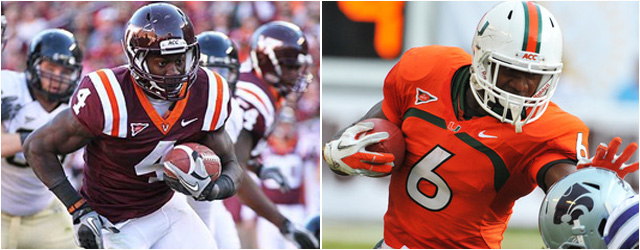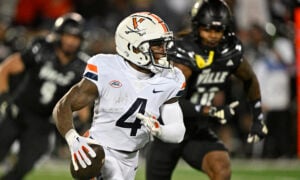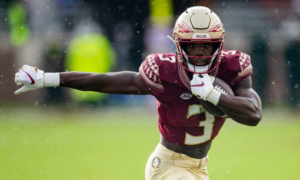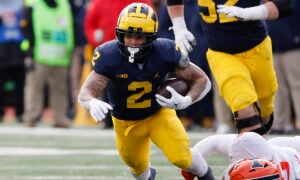Draft Duel: David Wilson vs. Lamar Miller
This year holds no secrets as to who will be the first running back off the board. Alabama’s Trent Richardson, who has been compared by many experts to be the best back since Adrian Peterson, is the clear choice. I am on record as not sharing the view that Richardson is “elite,” but without a doubt, he’s is in a class by himself in 2012 and will be first off the board. Battling for second running back honors are likely Virginia Tech’s David Wilson and Miami’s Lamar Miller.
If you’re sitting with picks 1.04 through 1.06, there’s a good chance you’re going to get a shot at one of these young backs. Boise State’s Doug Martin looks promising as well and fans here will likely argue this should be a three-way duel. I’m not of that mindset myself, but I don’t disagree that Martin is an intriguing prospect.
David Wilson
Virginia Tech
5’10″/206/4.49
Age: 20 (6/15/91)
[vsw id=”J1bO123KOEM” source=”youtube” width=”425″ height=”344″ autoplay=”no”]
While the first minute of the above highlight reel is beautifully awkward, what follows is a display of just how much there is to like about David Wilson.
First, he possesses near-elite balance within his foundation, below the hips. One of the primary factors I look for in difference-making backs in the NFL is the trait of what I call “swivel.” I like to see running backs whose legs appear to swivel below or detach from the hips. This trait allows for yardage, often times significant, after first contact or off glancing blows from defenders not squaring up. Wilson displays this in spades.
He also has a very effective side-step and natural lateral mobility, without the wasted movement that can turn it into lost yardage or indecision. Wilson shows confidence in where his lanes are going to form and effortlessly slides to the lane to avoid traffic. Once there, he has the burst into the secondary and gets to top speed quickly. Much quicker than he is fast, Wilson is capable, once in the secondary, of making defenders miss and getting to the sideline for further yardage.
Not overly adept in the passing game, he shows enough capability to develop into a threat in the flat. He’s able to display sufficient skill to catch on the move and uses his acceleration to, again, reach top speed quickly. As with most rookies, he has work to do in pass protection and his size, as used in his rushing game, could be used against him. His development in this area will be the key to him remaining on the field in clear pass protection down and distance situations.
Wilson tends to run a bit undisciplined at times and puts far too many balls on the ground. In the NFL, ball security issues will find a young player on the bench very quickly. And once on the bench, anything can happen. Wilson hasn’t yet shown the ability to properly secure the ball and the challenge in the NFL will be much more difficult.
Lastly, Wilson’s long speed is a bit in question and is evident on his highlight video above. While his agility dynamic that serves to break him into the secondary in undeniable, once there he is often tracked down from behind or can’t outrun defenders with a closing angle. This doesn’t eliminate Wilson from discussion as the second back off the board, but it could limit his upside potential at the next level.
As seen in his stat box below, Wilson was never a touchdown machine at Tech and I believe this does limit his upside in the NFL. However, with significant upside at only 20 years old, a potentially long career is also possible.
| SEASON | ATT | YDS | AVG | LNG | TD | REC | YDS | AVG | LNG | TD |
| 2011 | 290 | 1709 | 5.9 | 57 | 9 | 22 | 129 | 5.9 | 15 | 1 |
| 2010 | 113 | 619 | 5.5 | 68 | 5 | 15 | 234 | 15.6 | 65 | 4 |
| 2009 | 59 | 334 | 5.7 | 51 | 4 | 0 | 0 | 0.0 | 0 | 0 |
Lamar Miller
Miami
5’11″/212/4.40
Age: 20 (4/25/91)
[vsw id=”f7dxPzUBoi4″ source=”youtube” width=”425″ height=”344″ autoplay=”no”]
Also at 20 years of age, Lamar Miller brings a distinctly different package to the NFL than does his “Draft Duel” partner, David Wilson.
Miller has the prototypical size I like to see in my running backs. In my years of research and analysis, I desire backs to stand at 5’11” and weigh in at 217 lbs. Beggars can’t be choosers here with Miller as he’ll certainly add weight once within a strength training regimen of the NFL. Running a 4.40 in the forty was a pleasant surprise as I expected a mid 4.40 forty from tape I had watched.
Looking at Miller’s game, it’s an easy task to project him to the NFL level. He squares his shoulders early and often and has virtually no wasted movement in his approach to the line of scrimmage. His vision doesn’t appear to be elite, but is certainly passable when combined with his size and speed dynamic. Not containing the hip swivel or balance of Wilson, Miller won’t often create drawn out, dynamic runs with multiple cutbacks.
Miller’s primary positive attributes are his size and speed. Once into the lane and into secondary space, he’s got the body and speed to quickly put defenders in a trailing position. Once there, Miller’s legitimate 4.40 speed is on display as he’s rarely caught from behind. Would be front side tacklers better have help quickly as Miller’s strength and leg drive will make for many yards after contact. He runs with a great body lean and while often times he’s high coming through the line, he shows the ability to lower his pads.
Like Wilson, Miller didn’t excel in the passing game, but shows soft hands for a back of his size, as well as the ability to track and catch the ball fluidly. He’s a bit stiff in pass protection, but is willing. His size would allow for third down duty should he develop into a capable protection player. Also like Wilson, Miller wasn’t a prolific scorer but, unlike Wilson, I believe he has the NFL skill set and body to take advantage of a capable NFL offensive line and score at a level beyond his college production.
Miller’s relatively short stint at Miami is detailed below and he’s yet to be a workhorse at any level. Regardless of his NFL drafted situation, conditioning and getting beyond the rookie wall will be primary early hurdles.
| SEASON | ATT | YDS | AVG | LNG | TD | REC | YDS | AVG | LNG | TD |
| 2011 | 227 | 1272 | 5.6 | 79 | 9 | 17 | 85 | 5.0 | 16 | 1 |
| 2010 | 108 | 646 | 6.0 | 47 | 6 | 11 | 96 | 8.7 | 28 | 0 |
Summary
Even experts can’t seem to agree. Wilson garners a lot of confidence and Miller seemingly just as much. Look even deeper and Boise State’s Doug Martin also enters the conversation of “next off the board” after Trent Richardson.
To me, it’s not that close.
I’ve watched numerous tape on both runners and for my money, Lamar Miller stands head and shoulders above Wilson. Wilson’s speed and agility dynamic are intriguing to me, but the NFL is flush with agile and elusive runners who quickly become role players. With a game that is devaluing the running back position at an ever-quickening pace, I continue to turn my attention to backs who have what it takes to perform the primary function of an NFL rushing attack – physical, between the tackles running, with the speed to get outside when needed. Ball security, yards after contact, pass protection and the ability to move defenders backward are what keeps running backs on the field.
When I watch Lamar Miller run, I immediately see NFL potential. I don’t think electric, gimmicky or elusive. I think efficient, powerful and fast. When I mix in the potential fantasy relevance of Miller’s game, I see a back with a game similar to Arian Foster. In the right offense, Miller going to develop into a very capable every down potential back.
There’s no question that both backs, being as young as they are, have enormous potential. For me, the choice is clear – Lamar Miller wins this duel.
- Lineup Advice: Wrap-up, Thank You and Goodbye (TTFN) - January 1, 2024
- Lineup Advice: Week 17 – Championship Edition - December 26, 2023
- Lineup Advice: Week 16 – The “What is” Edition - December 19, 2023



































































